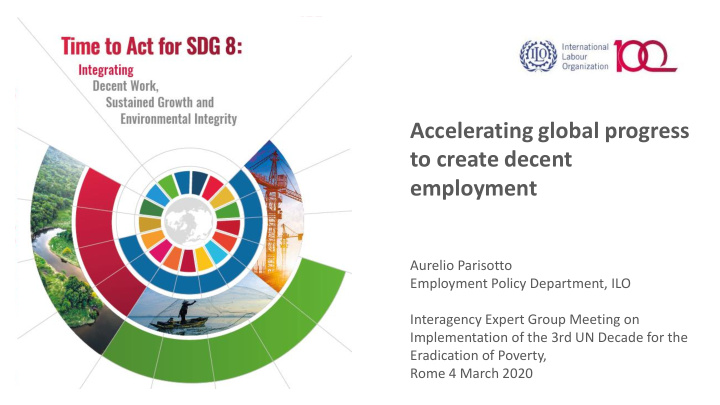



Accelerating global progress to create decent employment Aurelio Parisotto Employment Policy Department, ILO Interagency Expert Group Meeting on Implementation of the 3rd UN Decade for the Eradication of Poverty, Rome 4 March 2020
Key y messages “Better jobs are the most direct pathway out of poverty” (WDR 2013) Despite pockets of achievement, jobs gaps remain large and progress in delivering SDG8 is slowing down. How can we accelerate our efforts? Pursuing an “ integrated employment policy agenda ” at all levels can provide a new drive It is critical to recognize that decent jobs have large positive externalities for the poor and for the economy and society – Indirect pathways out of poverty
A1. Global employment gaps Global overview of access to employment and labour underutilization, 2019
A2. Access to paid work is is no guarantee of f a decent lif life Characteristics of global employment, 2019 (percentages) Source : WESO 2020, based on ILOSTAT, ILO modelled estimates, November 2019; ILO, 2018b.
A3. Decelerating decline in in working poverty Working poverty as a share of total employment 90 80 70 Low-income countries Share of workers (%) 60 50 Lower-middle income countries 40 30 Upper-middle income countries 20 10 Defined as a worker earning less than USD3.20 per day in PPP 0 1991 1996 2001 2006 2011 2016 2021 terms 5
A4. Uneven and subdued economic growth GDP per capita, country income groups, 2000 and 2018 (US$ PPP) Note : GDP aggregates are computed using PPP exchange rates. Source : WESO 2020, ILO calculations based on the World Bank’s WDI
A5. In Incomplete str tructural tr transformation Changes in the relative shares of employment and GDP by sector, selected countries, 2000-2018 or closest Manufacturing Agriculture Services
A6. The in increase of f employment in in services encouraged la labour market in informality
A6. Encouraging changes but t lit little global progress in in reducing th the youth NEET rate
A7. Growing la labour market participation of f women, stu tubbornly hig igh in inequality
B1. An in integrated policy agenda to promote a cumulative and cir ircular process towards SDG8 1. National employment policies fostering synergies across active macroeconomic policies ( demand-side ), targeted measures for structural transformation ( supply-side ), and inclusive labour market policies ( labour market transitions). 2. Labour market institutions, labour standards and social protection - to improve and protect the quality of jobs and incomes and to boost demand, enhance productivity and foster social cohesion. 3. Effective mechanisms for policy implementation, coordination, monitoring and evaluation
Active macroeconomic B2. Comprehensive policies national employment Sectoral and Inclusive labour enterprise market policies policies grounded in in a policies for Country-specific structural transformation whole-of of-government strategic policy mix approach With coordination Gender- mechanisms wage policies responsive Azerbaijan, Costa Ric ica, , policy framework Ethiopia … Skills development policies and lifelong learning
B3. Supporting economic tr transformations of f a new ty types – So Some le lessons le learnt Level of economic growth - Macroeconomic policies can be used more actively to support full employment and a stable path of investment and consumption Composition of growth - Targeted sectoral policies can help trigger productive transformation; eg incentives to greener industries and the care economy. Success however is often contingent on local circumstances Labour market access - Well-designed programmes can enhance labour market access for women, youth, poor people in rural areas, but hardly are a stand-alone solution. Focus on the quality of jobs (it generates externalities) - Labour standards, collective bargaining, minimum wage systems and social protection are not just costs or obstacles to efficiency. 13
B4. Strengthening mechanisms for im implementation • Inter-ministerial actions • Budgetary commitment to employment policies • More efficient employment services • Robust labour market information systems • Stakeholder participation and social dialogue • Capacity building
B4. Mult ltilateral cooperation a powerful tool • Coordinated fiscal and monetary policies • Stable and transparent rules-based trading system • Reduce cross-border tax evasion and tax elusion • Well-regulated global financial system • Mitigate and adapt to climate change – A global green new deal • Governing migration Explore new avenues Regional trade agreements, sectoral and local initiatives, networks …
B5. . Mult ltila lateral l cooperation is is a powerful tool • Coordinated monetary and fiscal policy easing • Stable and transparent rules-based trading system • Reduce cross-border tax evasion and reform of taxation of multinational corporations • Strengthen global financial safety nets • Mitigate and adapt to climate change – A “global new green deal” Explore new avenues for cooperation - regional agreements, sectoral and local initiatives …
Recommend
More recommend